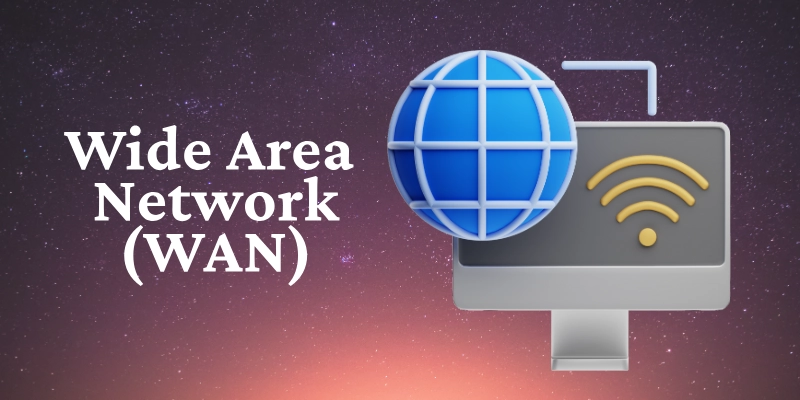LAN vs. WAN vs. MAN: Types of Networks
Published: 8 Sep 2025
Choosing the right network type can be frustrating if you don’t know the differences between LAN, WAN, and MAN. Set up the wrong one, and you may face slow speeds, high costs, or unnecessary complexity. Whether you’re managing a home office, running a business, or planning large-scale connectivity, understanding LAN vs. WAN vs. MAN will help you save time, money, and effort.
In this article, we will discuss LAN vs. WAN vs. MAN in detail to help you make the right choice.
What Are LAN, MAN, and WAN?
When talking about networking, three terms come up frequently: Local Area Network (LAN), Metropolitan Area Network (MAN), and Wide Area Network (WAN). Each represents a different scale of connectivity:
- LAN covers small areas such as homes, offices, or school labs.
- MAN connects users within a city or large campus (5–50 km).
- WAN spans countries, continents, or the entire globe (like the internet).
Understanding the difference between LAN, WAN, and MAN is essential to identify which network type best suits your needs.

LAN vs. WAN vs. MAN Comparison Table
Here is the comparison table of LAN, WAN, and MAN highlighting their main differences.
| Feature | LAN (Local Area Network) | MAN (Metropolitan Area Network) | WAN (Wide Area Network) |
| Geographic Range | Small (building/campus) | Medium (city/large campus) | Large (country/continent) |
| Speed | High (100 Mbps–10 Gbps) | Moderate (10–100 Mbps) | Variable (kbps–Gbps) |
| Ownership | Private | Public or private | Usually shared/multiple ISPs |
| Cost | Low | Moderate | High |
| Latency | Very low | Low to moderate | Higher due to distance |
| Fault Tolerance | Easy to maintain | Harder to maintain | Complex, requires backup |
| Examples | Office Wi-Fi, school labs | City-wide Wi-Fi, university campus | Internet, corporate WANs |
This LAN vs WAN vs MAN comparison makes it easy to see where each type fits in terms of scale, speed, and complexity.
Local Area Network (LAN)
A Local Area Network is designed for short-range connectivity, usually within a building or a group of nearby buildings.
Characteristics of LAN:
The following are the key characteristics of a Local Area Network (LAN):
- High-speed connections (Ethernet/Wi-Fi).
- Private ownership and easy management.
- Cost-effective and highly secure.

Examples of LAN:
Here are a few practical examples where LAN is used:
- Home Wi-Fi setups.
- Office or corporate networks.
- Computer labs in schools or universities.
LAN is ideal when you need fast, low-latency networking in a small area.
Metropolitan Area Network (MAN)
A Metropolitan Area Network sits between LAN and WAN in terms of coverage. It can link multiple LANs across a city or a large campus.
Characteristics of MAN:
A Metropolitan area network (MAN) can be identified by the following features:
- Covers areas of 5–50 km.
- Moderate speeds (faster than WAN, slower than LAN).
- Ownership may be private (university) or public (government, ISP).

Examples of MAN:
A Metropolitan Area Network can be seen in the following scenarios:
- City-wide Wi-Fi projects.
- University campus networks.
- Cable TV and DSL infrastructure.
MAN is often used by organizations needing seamless connectivity across large campuses or urban areas.
Wide Area Network (WAN)
A Wide Area Network connects devices and LANs across huge geographical distances, often through leased lines, satellites, or cloud-based technologies.
Characteristics of WAN:
Below are the essential characteristics of LAN in computer networks:
- Spans regions, countries, or continents.
- Slower than LAN but improving with fiber and SD-WAN.
- Expensive and complex to set up and manage.

Examples of WAN:
These are some typical examples of WAN in everyday life:
- The internet (largest WAN).
- Corporate networks connecting multiple branches.
- Intercontinental communication systems.
WAN is essential for global communication and enterprise connectivity.
Choosing the Right Network
When deciding between LAN, WAN, and MAN, consider these factors:
- LAN → Best for homes, small businesses, and local networks where speed and cost-efficiency matter.
- MAN → Suitable for universities, municipalities, or organizations needing city-level coverage.
- WAN → Ideal for enterprises, government organizations, or businesses operating internationally.
This LAN vs MAN vs WAN comparison helps ensure you don’t overpay or underbuild your network.
Future Trends
The boundaries between LAN, MAN, and WAN are evolving:
- LANs are getting faster with Wi-Fi 6/6E and 10 Gbps Ethernet.
- MANs are less common but still serve urban infrastructure projects.
- WANs are becoming smarter with SD-WAN, cloud networking, and 5G, reducing traditional drawbacks like high latency and cost.
Conclusion
In summary, the difference between LAN, MAN, and WAN lies mainly in scale, speed, ownership, and cost.
- LAN: small, fast, affordable.
- MAN: medium coverage, moderate cost.
- WAN: global, complex, and expensive but vital for large-scale communication.
By understanding the LAN vs. WAN vs. MAN comparison, you can make smarter decisions about which network type best fits your home, business, or enterprise needs.
💬 We’d love to hear your thoughts share your views in the comments below
FAQs
Below are the most common questions people ask about LAN vs WAN vs MAN, along with simple answers:
The difference between LAN, WAN, and MAN is mainly in the coverage area. LAN connects small spaces like homes or offices, MAN covers larger areas such as cities, and WAN spans countries or the internet itself. This LAN vs WAN vs MAN comparison helps decide which is right for your needs.
In a LAN vs WAN vs MAN speed comparison, LAN is usually the fastest because it works over short distances. MAN provides moderate speeds, while WAN is slower due to long-distance connections. However, modern WANs with fiber and 5G are improving rapidly.
Yes, you can set up a Local Area Network (LAN) without the internet. Devices can still share files, printers, and play LAN games. The internet is only needed when you want global access, which falls under WAN networks.
In the LAN vs MAN vs WAN comparison, MAN is less common because faster WAN technologies now cover most city-level needs. Still, MANs are useful for campus networks and urban infrastructure projects. They act as a bridge between local LANs and larger WANs.
- LAN examples: Office Wi-Fi, home networks, school labs.
- MAN examples: City-wide Wi-Fi, university networks.
- WAN examples: The internet, global corporate branches.
These examples of LAN, MAN, and WAN make the concepts easy to understand.
For small businesses, LAN is the best option because it’s affordable, fast, and secure. It supports file sharing, internet access, and office collaboration. As the business grows, WAN may be needed to connect multiple locations.
Not always. While the internet is the largest WAN, private WANs also exist to connect company branches across regions or countries. This shows that in the LAN vs WAN vs MAN difference, WAN can be both private and public.
- LAN: Ethernet, Wi-Fi, switches, routers.
- MAN: Fiber optics, Metro Ethernet, WiMAX.
- WAN: MPLS, VPN, leased lines, satellites, cloud services.
These highlight the technologies behind LAN vs WAN vs MAN networks.
In terms of cost, WAN is the most expensive because it requires complex infrastructure like leased lines and satellites. MAN is moderately expensive, while LAN is the cheapest and easiest to set up. This makes cost a major factor in the LAN vs WAN vs MAN comparison.
Your choice depends on coverage, speed, and budget. Use LAN for small spaces, MAN for city-level connectivity, and WAN for global communication. Understanding the difference between LAN, MAN, and WAN helps you pick the most efficient network type.

- Be Respectful
- Stay Relevant
- Stay Positive
- True Feedback
- Encourage Discussion
- Avoid Spamming
- No Fake News
- Don't Copy-Paste
- No Personal Attacks

- Be Respectful
- Stay Relevant
- Stay Positive
- True Feedback
- Encourage Discussion
- Avoid Spamming
- No Fake News
- Don't Copy-Paste
- No Personal Attacks





